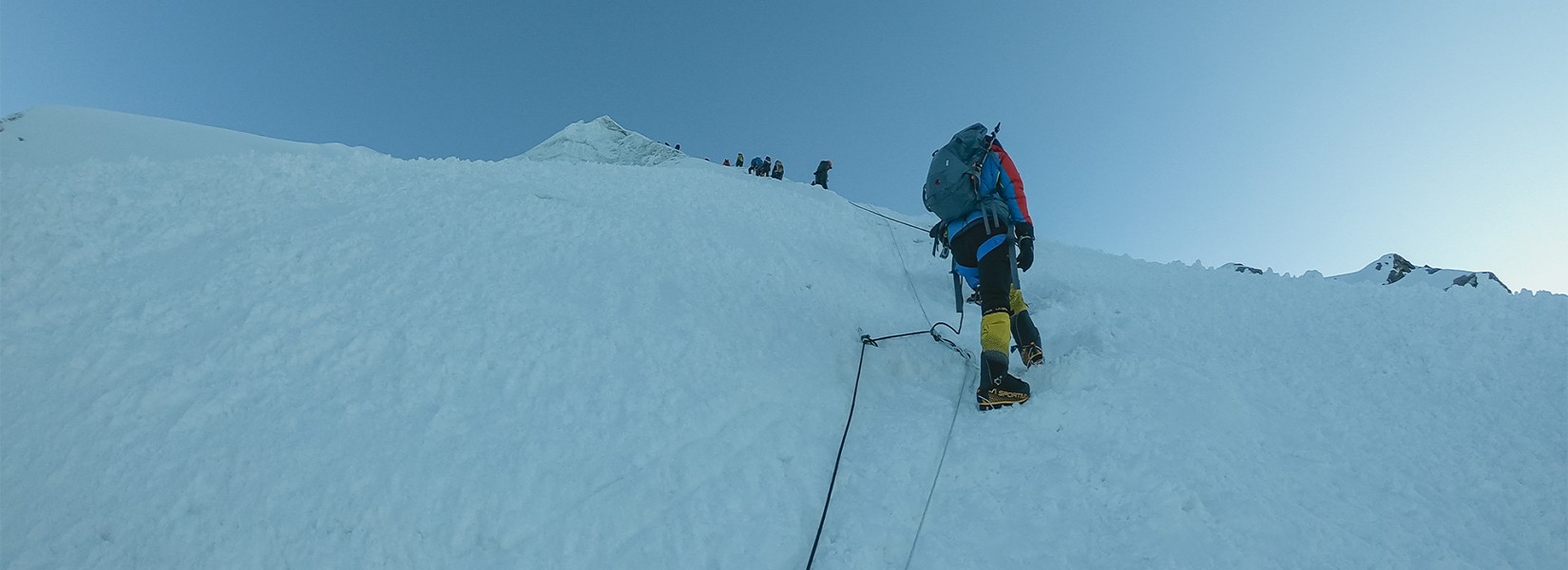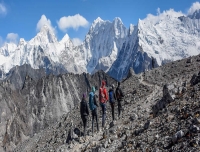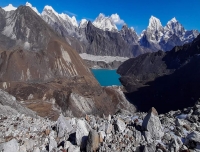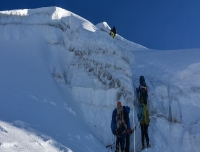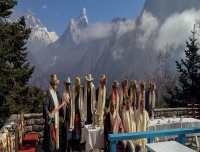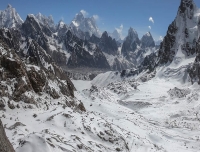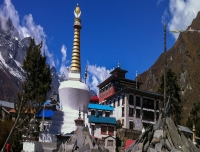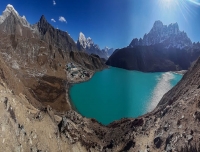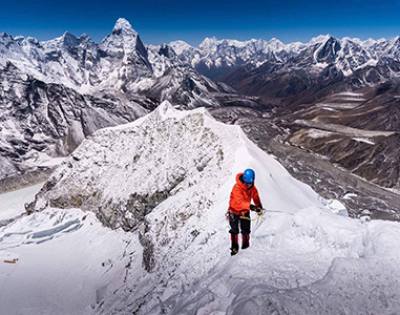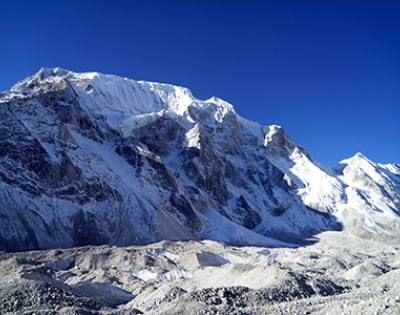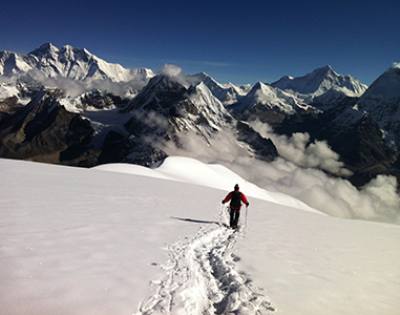- Read Reviews onTripadvisor
- Phone & WhatsApp Support+977 9851112535 (Chandra Shor)
Island and Lobuche Peak Climbing Combines Classic EBC Trek | 24 Days
Fact Information
- Duration
- 24 Days
- Destination
- Nepal
- Difficulty
- Difficult
- Accommodation
- Hotel, Lodge &Tent
- Activity
- Peak Climbing
- Transportation
- Tourist Bus, Car & Airplane
- Meals
- BLD (Breakfast, Lunch and Dinner)
- Max Person
- 18
- Min Person
- 2
- Location
- Everest region
- Best season
- Autumn & spring
About Trip
The Island Peak (6,189 meters) and Lobuche East Peak (6,119 meters) climbing, as well as the classic Everest Base Camp trek in Nepal, offer incredible and diverse landscapes.
Island Peak is a popular trekking peak located in the heart of the Everest region and offers stunning views of the surrounding mountains, including Mount Everest. The peak itself presents a challenging climb that requires basic mountaineering skills. The trek to Island Peak starts with a flight to Lukla and follows the classic route to the village of Namche Bazaar, known as the Sherpa capital and a bustling tourist hub in the remote region of Nepal. Trekkers typically stay in Namche for two nights to acclimatize before heading towards higher elevations. The trek then continues to the Everest Base Camp before reaching the Island Peak Base Camp. The final ascent to the summit involves a steep snow headwall, a rocky trail, and often requires the use of crampons, an ice ax, and guide ropes or fixed lines. The views from the summit are truly breathtaking, offering a panoramic view of the Himalayas, including nearby peaks such as Lhotse, Lhotse Middle, Lhotse Shar, Makalu, and Ama Dablam, among others.
Lobuche East Peak is another challenging but rewarding trekking peak located near the popular Everest Base Camp trek route. The trek to Lobuche East Peak involves following the trail through rocky moraines, huge rock slabs, and then making a steep ascent up snow slopes to the summit. The views from the top are breathtaking, offering a panoramic view of the surrounding peaks, including mighty Mount Everest, Makalu, Pumori, Nuptse, and Lhotse.
The classic Everest Base Camp trek takes you to the base of the world's highest mountain, Mount Everest. The trek starts with a flight to Lukla and then follows the trail through the heart of the Khumbu region, passing through traditional Sherpa villages, crossing high suspension bridges, and offering stunning views of the surrounding peaks along the way. The final destination, the base camp, is located at the foot of Mount Everest and offers a view of the impressive glaciers and ice cliffs of the Khumbu Icefall.
Trip Highlights
Scenic flight to Lukla: The flight to Lukla offers stunning views of the Himalayas, including Mount Everest.
Views of the surrounding peaks: The trail to Island Peak offers incredible views of some of the world's tallest mountains, including Mount Everest, Lhotse, and Makalu.
Cultural immersion: The trek passes through traditional Sherpa villages, offering a chance to learn about the local culture and way of life.
The summit climb: The final ascent to the summit of Island Peak is a challenging and rewarding experience, offering stunning panoramic views of the surrounding peaks.
Some of the highlights of the Lobuche East Peak trek include: Views of the surrounding peaks: The trek to Lobuche East Peak offers incredible views of some of the world's tallest mountains, including Mount Pumori, Nuptse, and Lhotse.
The summit climb: The final ascent to the summit of Lobuche East Peak is a challenging and rewarding experience, offering stunning panoramic views of the surrounding peaks.
Some of the highlights of the classic Everest Base Camp trek include: Views of the surrounding peaks: The trek to Everest Base Camp offers incredible views of some of the world's tallest mountains, including Mount Everest, Lhotse, and Nuptse.
Cultural immersion: The trek passes through traditional Sherpa villages, offering a chance to learn about the local culture and way of life.
The base camp experience: Arriving at the base camp of Mount Everest is a truly unforgettable experience, offering stunning views of the surrounding glaciers and ice cliffs.
Outlined Itinerary
Day 01: Arrival in TIA Kathmandu Airport 1,340 m, (4,429 ft), transfer to hotel.
Day 02: Special climbing preparation day, permits, and gears, welcome dinner.
Day 03: Drive to Ramechhap airport 135km, to fly Lukla and trek start to Phakding (2,610m).
Day 04: Trek from Phakding to Namche Bazaar 3,440 m, (11,286 ft), 5hrs.
Day 05: Hike to Everest view Hotel 3,870 m, (12,697 ft), for the panoramic view.
Day 06: Trek from Namche to Tengbuche Monastery 3,860 m, (12,664 ft), 5hrs.
Day 07: Trek from tengboche to Dingbuche village 4,410 m, (14,468 ft), 5hrs.
Day 08: Hike to Nangkartshang viewpoint 5,083 m, (16,676 ft), 3hrs.
Day 09: Trek from Dingboche to Lobuche 4,910 m, (16,108 ft), 5hrs.
Day 10: Trek Lobuche to Gorak sep 5,171 m, 3hrs, afternoon hike to Kalapathar 5,550 m.
Day 11: Trek to EBC 5,364 m, (17,598 ft), and return to Lobuche Lodge
Day 12: Trek to Lobuche base came 4,940 m, (16,210 ft), 3hrs, stay in tented camp.
Day 13: Attempt summit 6,119 m, (20,075 ft), back to Pheriche.
Day 14: Contingency day.
Day 15: Trek over Khongma La pass 5,535 m (18,159 ft), Chhukung 4,730 m, (15,518 ft).
Day 16: We trek to Imja-Tse (Island) base camp 4,970 m (16,305 ft) 3hrs.
Day 17: Attempt summit 6,189m (20,305 ft), back to Chhukung.
Day 18: Contingency day.
Day 19: Trek back to Tengboche monastery 3,860 m (12,664 ft) 5hrs.
Day 20: Trek back to Namche 3,440 m, (11,286 ft).
Day 21: Trek back to Lukla 2,860 m, (9,383 ft).
Day 22: Fly back to Ramechhap airport and drive to Kathmandu 1,350m, transfer to hotel.
Day 23: Rest or shopping day, evening farewell dinner.
Day 24: Departure for country, drop you off in international airport.
Detailed Itinerary
Day 01: Arrival in TIA of Kathmandu 1,350 meters (4,429 ft), transfers to hotel.
Representatives from Himalayan Diamond Adventures will greet you upon your arrival at Tribhuvan International Airport in Kathmandu. You will be welcomed with a fresh flower garland, a traditional Nepali greeting, and then escorted to the hotel for bed and breakfast service. The drive from the airport to the hotel takes approximately 15 to 20 minutes, if there is no traffic jam on our way. After checking into the hotel, we will have a short refreshment meeting at the hotel. In the evening, the company will host a welcome dinner at a traditional Nepali restaurant, complete with a cultural dance performance, to celebrate the start of your trip. During the dinner, your guide will provide a brief overview of the schedule for the following day.
Accommodation: 3 to 5 Stars standard of hotel.
Transportation: Private tourist bus or car.
Meals: Welcome Dinner includes drinks.
Day 02: Climbing preparation day before leaving mountain.
If you are not well equipped, it is a good idea to collect climbing gear before leaving on your trip. There are many trekking gear shops around Thamel Bazaar where you can purchase the necessary equipment.
Accommodation: 3-to-5-star hotel.
Meals: Breakfast with hot drinks.
Day 03: Fly to Lukla 2,840m (9,317 ft), trek begins to Phakding 2,610m (8,563 ft), 2. 3hrs.
Tomorrow morning, we will take off from Ramechhap airport with an early flight, so we will need to leave the hotel in Kathmandu very early. The drive to Ramechhap airport will take approximately 5 to 6 hours in private vehicle, covering a distance of 135 kilometers. From Ramechhap airport, we will take a short but exciting flight to Lukla Hillary airport, known for its challenging short and narrow runway. After a short stop in Lukla for last-minute trip preparations, we will begin our journey to Phakding. The trek will take us along a straightforward trail, passing through picturesque Sherpa villages and spiritual sites with breathtaking panoramas. After 2.5 to 4 hours of leisurely trekking, covering a distance of 7.5 km (4.6 miles), we will reach Phakding at an altitude of 2,610m (8,563 ft).
Maximum Elevation: 2,860m, (9,383 ft).
Trekking hours: 2.5 hrs, 200m descent, 50m ascent.
Accommodation: Lodge.
Meals: L, D, B with hot drinks.
Day 04: Trek to Namche Bazar 3,440 meters, (11,286 ft), 5-6 hours.
It's our second day of hiking in the mountains, and we are very excited to start the journey. In the morning, we will follow the Dudh Koshi River valley, passing through the vibrant villages of Toktok, Bengkar, and Monjo, as well as waterfalls and high suspension bridges with breathtaking views of Mount Kusumkhanggaru. After 2 to 3 hours of pleasant and slightly uphill trekking from Phakding, we will reach the Sagarmatha National Park, where we will need to present our permits and enter. Today, we should have an early hot lunch before departing from the last settlement of Jorsalle. After leaving Jorsalle, there will be no opportunities to eat hot meals until we reach Namche Bazar. Our trail continues straight ahead to the confluence of the Dudh Koshi and Bhote Koshi rivers. Before starting the challenging uphill trail, we will come across the famous Hillary Bridge, the highest bridge on the way to Everest base camp. After 2 to 3 hours of strenuous uphill trekking, we will reach the bustling town of Namche Bazar, the Sherpa capital, which is located at an altitude of 3,440 meters from the epic Hillary Bridge. Our trek today will take about 5 to 7 hours, covering a distance of 12.5 kilometers, with stunning landscapes throughout the journey from Phakding.
Elevation: 3,440 meters, (11,286 ft).
Trekking hours: 5 hours, 10,00m ascent, 100m descent.
Accommodation: Lodge the attached bathroom.
Meals: B, L, D with hot drinks.
Day 05: Hike to Everest view Hotel 3,870m (12,697 ft), for panorama view.
Today is a rest day for us, it's very important to take a rest day after rapidly ascending a mountain. Even though we don't take a rest, we will hike to the Everest View Point (3,867m or 12,687ft) for the best panoramic view of Mount Everest and other beautiful mountain views. If we have time, we will visit Khumjung village, the Yeti Scalp Monastery, and the Mountain Museum in Namche Bazaar."
Overnight stay at a lodge in Namche Bazar.
Maximum elevation: 3,870m, (12,697 ft).
Visit: Khumjung village and Hillary school.
Accommodation: Lodge.
Meals: B, L, D with hot drinks.
Day 06: Trek to Tengboche Monastery 3,860 meters (12,664 ft), 5 hours.
Today, we're on day three of our mountain trek to Tengboche Monastery (altitude of 3,860 meters). The hike will take about 5-6 hours, covering 9.2 km from Namche, surrounded by stunning mountain views. The trail starts with a difficult path above Namche Bazar, but quickly becomes easier with breathtaking views of Mount Everest, Lhotse, Thamserku, and Amadablam. After a relaxing hike along the Kyangjuma valley and a break for lunch at Phunge Thanga, the trail becomes challenging from the Armi checkpoint area until Tengboche Monastery. The hike is difficult, but more enjoyable in April to May when rhododendron flowers bloom. This evening, we will visit the significant Tengboche Monastery.
Maximum Elevation: 3,860 meters, (12,664 ft).
Trekking hours: 4 to 5 hours, 350m descent, 750m ascent.
Accommodation: Lodge.
Meals: B, L, D with hot drinks.
Day 07: Trek to Dingboche village 4,410 meters, (14,468 ft), 5 hours.
Today we will trek to Dengboche village, the last major settlement before EBC, in a 6-7 hour hike covering 6.5 miles (10.5 km). We will start with a slight descent through a forest of silver pines, birches, and rhododendrons with magnificent views of Everest, Lhotse, and Amadablam and cross the Imja Tse stream on a high suspension bridge. After crossing the bridge over the Imja river, the trail ascends slightly to Pangboche village with a breathtaking view of Mount Amadablam. We will stop for lunch at Somare. After lunch, we will continue on an off-the-beaten trail with a gradual ascent to Dingboche village, our final destination with stunning views of Lhotse and Lhotse Shar.
Maximum Elevation: 4,410 meters, (14,468 ft).
Trekking hours: 4 to 5 hours, 70 descent, 580m ascent.
Accommodation: Lodge.
Meals: Breakfast, Lunch, Dinner with hot drinks.
Day 08: Acclimatization Day, hike to Nangkartshang viewpoint 5,083 meters (16,676 ft), 3 hours.
Today is our designated rest day. It's crucial to take a break after quickly ascending in the mountains. If we choose not to rest, we will climb Nangkartshang Hill for 360-degree views of the surrounding peaks, which is also good for acclimatization. From the top, we will see breathtaking views of Island Peak, the most popular peak in the region, and Mount Makalu, located in the distance. After admiring the views, we will return to T-House for a hot lunch and rest.
Maximum Elevation: 5,083 meters, (16,676 ft).
Hiking hours: 4 hours, 400 m, ascent.
Accommodation: Lodge.
Meals: B, L, D with hot drinks.
Day 09: Trek to Labuche 4,910 m, (16,108 ft), 5hrs.
Today, on our two-day stay in Dingboche, we will trek to Lobuche, which is located at an altitude of 4,910 meters. The trek will pass through wide Yak and horse grazing lands, yak herders' huts above Pheriche village, and a small Khumbu Glacier's milk river. Before starting the strenuous uphill trail, we will stop at Thukla Sherpa village to refill our energy. We will also see chortens built in memory of those who lost their lives in attempts to climb Mount Everest and Lhotse peak. Today's hike will take 5-6 hours and cover a distance of 10.7 km, ending in Lobuche where we will check into our rooms for some rest. Afterwards, we will hike to the Khumbu glacier viewpoint.
Maximum Elevation: 4,910 meters, (16,108 ft).
Trekking hours: 4 to 5 hours, 500m ascent.
Accommodation: Lodge.
Meals: B, L, D with hot drinks.
Day 10: Trek to Gorapse the last settlement 5,171 meters, (16,965 ft), 6hrs.
Today, we will embark on a trek from Lobuche to Gorakshe, following the edge of the Khumbu glacier and passing through rugged moraines. The trail takes a slightly uphill direction, offering stunning views of the surrounding mountains along the way. After a slow hike of 3 to 4 hours, covering a distance of 2.8 miles (4.5 kilometers), we will reach Gorakshe village, the final permanent settlement on the Everest Base Camp trail. After enjoying a hot meal in Gorakshe, we will hike to Kalapatthar (5,550 meters) to witness a beautiful sunset view of the magnificent Mount Everest.
Maximum Elevation: 5,550 meters, (18,208 ft).
Hike: Kalopathar for the best Everest view.
Trekking Hours: 6 to 7 hours, 250m ascent.
Accommodation: Lodge.
Meals: B, L, D with hot drinks.
Day 11: Everest base camp 5,364m (17,598 ft), trek back to Lobuche, 8hrs.
Today is the final day of our Everest Base Camp (EBC) trek, as per our plan. We will make our way to the base camp by trekking along the moraine on the edge of the Khumbu Glacier. The trail ahead is slightly uphill and rugged, but it offers breathtaking views of the mountains and glacier. After approximately 2 to 3 hours of trekking, covering a distance of 7.2 kilometers or 4.5 miles, we will finally reach the Everest Base Camp. There, we will encounter rock cairns and prayer flags fluttering in the wind. If we are trekking during spring season, we may come across many climbers and see a spectrum of colorful tents throughout the base camp. After taking a few moments to appreciate and reflect on our successful journey, we will retrace our steps to Gorak Shep, where we will enjoy a hot lunch and continue our descent to Lobuche.
Day 12: Trek to Lobuche base camp 4,940 m, (16,210 ft), 3hrs, stay in tented camp.
After our beautiful Everest Base Camp trek today, we will travel to the Lobuche base camp for a climbing trip. We will trek through a pasture and a rocky trail, with some challenging climbing on the mountain side. After 3 to 4 hours of slowly climbing uphill, we will reach the Lobuche base camp, where we will set up camp in tents for the night.
Maximum Elevation: 5,200 meters
Trekking duration: 3hrsrs,
Accommodation: Tent camp
Meals: B, L, D with hot drinks.
Day 13: Attempt to Lobuche East Peak 6,119 m, (20,075 ft), back to Lobuche.
We will start climbing early in the morning, around 2:00 AM, before dawn, using headlamps. During the initial stages, we will climb on large rock slabs with the support of guide ropes. For the final summit, we will rely on fixed line ropes and Jummer. The climbing day will be demanding, but the views are breathtaking. We will be surrounded by an unparalleled panoramic view, including the mighty Mount Everest, Lhotse, and Makalu. After taking in the mesmerizing view from the summit, we will descend back to Lobuche or Dingboche for next Island climbing.
Climbing duration: 8hrs, ascent 919m, descent 919m.
Accommodation: Tented camp.
Meals: Breakfast, Lunch & Dinner with hot drinks.
Day 14: Contingency day.
Many plans for these tours are contingent upon weather conditions. If we fall behind schedule due to unfavorable weather, flight cancellations, or any other reasons, we will attempt to make up for it with an additional day, such as today. If we are on schedule, we will continue our trek to chhukung for next Island peak climbing.
Elevation: 3,860 meters, (12,664 ft).
Trekking hours: 7 hours
Accommodation: Lodge.
Meals: B, L,D with hot drinks
Day 15: Kongma La 5,535 m (18,159 ft), Chhukung 4,730 m, (15,518 ft), 8/9hrs.
Today, we head towards another spectacular destination called the Kongma La Pass, which is located at an elevation of 5,555 meters. Starting from Lobuche, we will cross the Khumbu glacier and face the challenging moraines trails to reach the Kongma-La Pass. The journey may be strenuous, but it will reward us with stunning mountain views, including a panoramic view of Lobuche Peak, Cholatse, and the surrounding Chhukung Valley. Please note that there are no tea shops between Lobuche and Chhukung, so it's important to carry enough water and a packed lunch from Lobuche. After crossing the pass, we will trek down to Chhukung, where we will be treated to breathtaking views of mountains such as Island Peak, Lhotse Shar, Ama Dablam, and more.
Maximum elevation: 4,730 meters (15,518ft).
Trekking duration: 8hrs, ascent 625m, descent 80m.
Accommodation: Lodge.
Meals: Breakfast, Lunch, Dinner with hot drinks.
Day 16: We trek to Imja-Tse (Island) base camp 4,970m, (16,305 ft).
Today, after proper acclimatization during the EBC, Kalapatthar, and Kongma La Pass trekking, we are heading towards the Imja-Tse / Island Peak Base Camp to attempt the peak. To reach the base camp, we will follow the Imja Tse valley along a narrow and rugged off-beaten track that gradually ascends to the Island Peak Base Camp. After slowly trekking for about 3 hours, we will arrive at the base camp. After taking a rest, we will review and refresh some climbing tips at the base camp.
Maximum elevation: 4,970 meters (16,305 ft).
Trekking duration: 3hrs, ascent 240m.
Accommodation: Tented camp
Meals: Breakfast, Lunch, Dinner with hot drinks.
Day 17: Attempt summit 6,189m (20,305ft), back to Chhukung.
Today is our summit day for Island Peak (6,189 meters). We will wake up at midnight for breakfast and climbing preparation, and then depart from the Island Peak Base Camp at 1 AM. After a short walk from the base camp, we will reach the trail that is covered with rocks and slabs of rock before arriving at the crampon point.
Our route will then take us through permanent snowfields and crevasses, and we will navigate through several challenging crevasses to reach the slope of the peak. We will then climb an incline of 75 to 85 degrees and a sharp ridge, with the support of a fixed-line rope. From the top of the peak, we will be rewarded with breathtaking 360-degree mountain views, including those of Lhotse, Lhotse middle, Lhotse-Sar, Makalu, Barunche, Amphu Peak, Ama Dablam, and the picturesque views of Dingboche, Tengboche, and Khumjung down the valley, all at an altitude of 6,189 meters, (20,305 ft). Finally, we will descend from the summit to Chhukung, taking in the mesmerizing valley views.
Day 18: Contingency day.
Today is a reserve day in case the planned summit day of Island Peak (6,189 meters) is impacted by unfavorable weather. As there is no guarantee of good weather on our planned day 14, we are keeping a day off as a contingency plan to ensure that we can make up for any delays in our schedule.
Day 19: Trek to Tengboche monastery 3,860m, (12,664 ft).
Today, after a successful climb, we will trek down to the Tengboche Monastery. This journey is expected to take approximately 5 to 7 hours, and we will be hiking past Sherpa villages, mani walls, gompas, bridges, lodges, and a rhododendron forest. Throughout our descent, we will have the opportunity to admire the stunning views of Mount Everest and Ama Dablam, and immerse ourselves in the local culture by interacting with the Sherpas.
Maximum elevation 3,860 meters (12,664ft).
Trekking duration: 7hrs, descent 870m.
Accommodation: Lodge.
Meals: Breakfast, Lunch, Dinner with hot drinks.
Day 20: Trek back to Namche 3,440 meters, (11,286 ft)
Today, we will retrace our steps back to Namche along the same trail. Throughout the trek, you will have the opportunity to enjoy the magnificent views once again. After approximately 4 hours of trekking, both uphill and downhill, we will arrive in Namche.
Day 21: Namche Bazaar - Lukla 2,860m (9,175 ft), 7-8 hrs.
Today, we will retrace our steps back to the starting point of our journey in Lukla. This will take approximately 8 hours of trekking, mostly consisting of a descent, with some gradual uphill sections along the way. We will pass by the confluence of the Dudh Koshi River and Bhote Koshi River and many vibrant Sherpa villages. Today, we will hold a dinner party to celebrate the successful completion of our trip.
Elevation: 2,860 meters, (9,383 ft).
Trekking hours: 8hrs, 960m descent, 250m ascent.
Accommodation: Lodge.
Meals: B, L, D with hot drinks.
Day 22: Fly to Ramechhap airport and drive back to Kathmandu hotel 1,350 m, (4,429 ft) 7hrs.
After an unforgettable journey, we'll fly to Ramechhap and drive back to Kathmandu. To celebrate the trip, we'll have a farewell dinner in this evening at a Nepali cultural restaurant, complete with traditional dance
Day 23: Valley sightseeing.
We'll tour UNESCO World Heritage sites in the Kathmandu Valley, including Pashupatinath, Swayambhunath, Patan Durbar Square, and Boudhanath. Pashupatinath and Swayambhunath are religious shrines revered by Hindus and Buddhists. Boudhanath also showcases the religious and cultural diversity of Nepal. Additionally, we'll visit Bhaktapur Durbar Square and Patan Durbar Square, two royal palaces with historical significance and monuments.
Return back to the hotel and overnight stay.
Transportation: Tourist Bus.
Permits: Entry Permits of Patan, Bhaktapur, and Kathmandu.
Accommodation: 3 Stars standard of hotel.
Meals: Farewell Dinner and Breakfast.
Day 24: Finally, departure.
We'll drop you off at Tribhuvan International airport and say goodbye as you head home
Note: that the outlined itinerary is designed for those who prefer a full package service. However, we understand that preferences and time constraints may vary, so we offer the flexibility to customize the itinerary according to your needs. The selection of itineraries and staff will be based on your specific requirements and budget. Additionally, we have options available for partial visits to accommodate your preferences and financial situation.
Cost Details
What's included
1. Airport pickup and drop off by the private vehicle as per your itinerary.
2. 3 Overnight Hotel Moonlight in Kathmandu included breakfast.
3. KTM to Ramechhap airport and Ramechhap airport to KTM Hotel transportation by private Car.
4. Ramechhap/Lukla/Ramechhap flights fare included 15Kg luggage.
5. The menu on client’s choice, Three meals in a day (Breakfast, Lunch, Dinner & Fresh fruits), with (hot drinks, like tea, Coffee, Ginger lemon, Ginger lemon tea, Ginger lemon honey, hot chocolate, milk tea, milk coffee, hot water).
6. T- house accommodations during the trek, clean and comfortable. Lukla, Namche and Dingboche rooms with private western toilet.
7. Entry permits: Peak permits, Garbage deposited $1000.00, Sagarmatha National Park fee and Pasang Lhamu Municipality fee.
8. Climbing grouping gears, dynamic Ropes, static Ropes, Snow bar, Ice crew, Carabineers, Runners, Rock Pitons, Auxiliary cords (All necessary gears).
9. Two-man sharing big North Face VE 24 tent, comfortable mat, dining hall, armchair, clean table with solar light.
10. Sufficient and tasty hygienically prepared food with a variety of drink.
11. Satellite Phone & Radio set for communication
12. We have available personal climbing gears, Harness, Helmet, Jumer, Crampon, Ice, boots, Figure 8 (Pay extra at a reasonable cost).
13. Transportations: - Private car pick up and drop off for domestic and international Airport.
14. One day valley sightseeing, Patan, Bhaktapur, and Ktm with city guide with transportation.
15. Guide: Myself.
16. One Strong and helpful porters between two members with proper equipment, Warm clothing and required trekking gear for porters like Gore-Tex jacket /trousers, trekking shoes, woolen hat, woolen gloves, woolen socks, sunglasses, etc.
17. Nepalese staff’s insurance policy covered emergency rescue evacuation helicopter, Hospitalization, medical treatment and accidental.
18. Medical supplies (first aid kit will be available).
19. Company's complimentary: Duffle bag, Map and company T-short.
20. Hot bag services.
21. Government taxes and official expenses.
22. Entry fee: UNESKO heritage sites.
23. Welcome dinner and farewell dinner in Nepali cultured restaurant
What's not included
❖ Personal trekking equipment and gears.
❖ Nepal entry visa fee.
❖ International airfare bill.
❖ Extra night accommodation in Kathmandu because of early arrival, late departure, early return from mountain (due to any reason) than the
❖ Meals while you stay in Kathmandu Hotel Lunch and Dinner.
❖ Your travel insurance policy should be covered rescue evacuation, medical treatment and accidental.
❖ Any entry fee for the temple or monastery.
❖ Donations or charity.
❖ Your personal expenses like; Hot shower, Laundry, Battery charging, telephone, WIFI, and shopping, etc.
❖ Alcoholic and non-alcoholic alcoholic hot and cold drinks.
❖ Tips for the guide, porter, and driver (tipping is expected)
Map
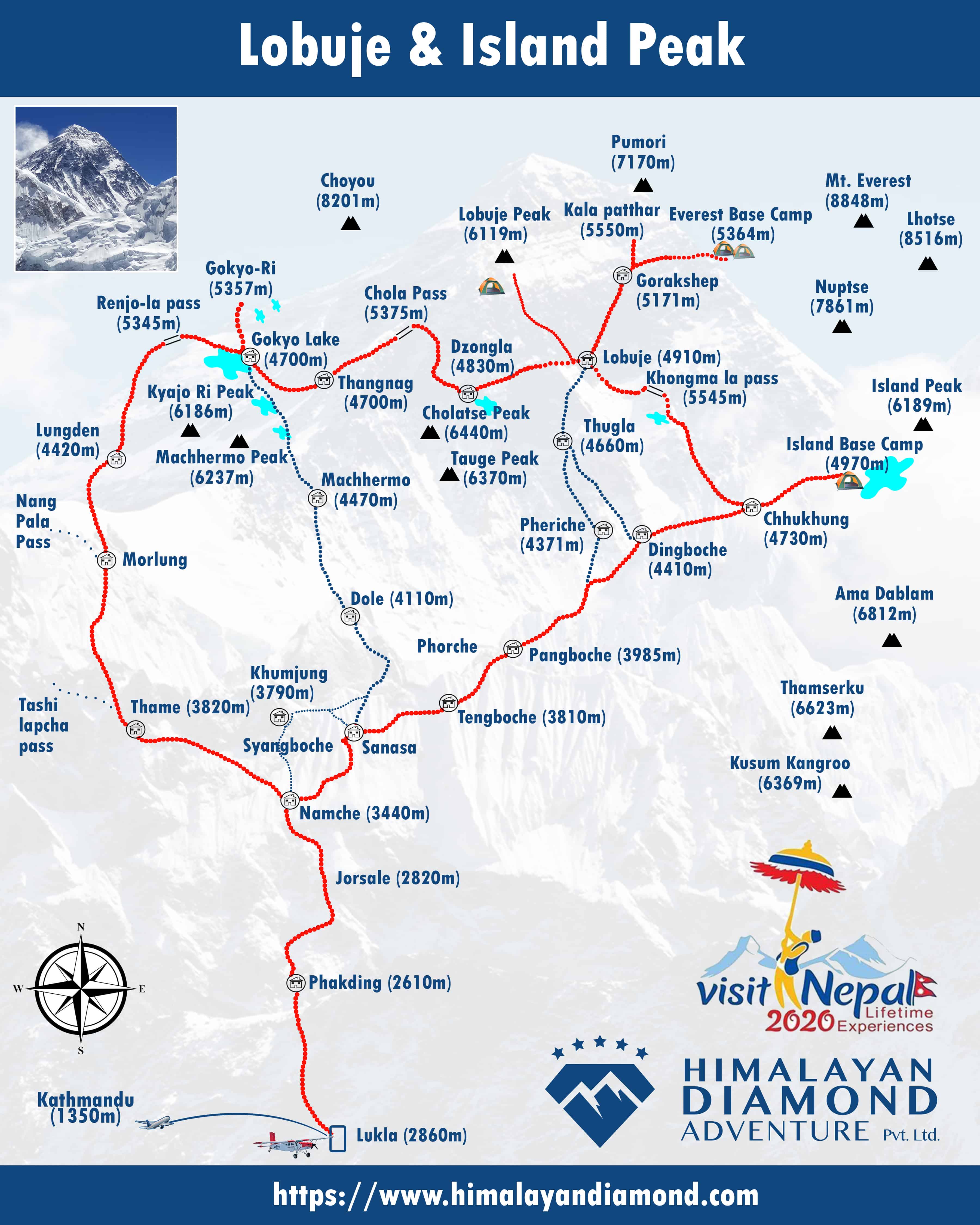
Useful Info
What Essential Documents Do I Need To Bring With Me On Tour?
When going on a tour, it's important to bring essential documents to ensure a smooth and hassle-free trip. Here are some documents that we highly recommend you bring with you.
Passport: If you're traveling to a foreign country, you'll need a valid passport. Make sure to check the expiration date and renew it if necessary.
Visa: Depending on your destination, you may need a visa to enter the country. Check with the embassy or consulate of the country you're visiting to see if you need a visa.
Travel itinerary: It's always a good idea to have a printed copy of your travel itinerary, including flight and hotel reservations, tour bookings, and any other important travel plans.
Travel insurance: Consider purchasing travel insurance to protect yourself against unforeseen events, such as trip cancellations, medical emergencies, and lost or stolen luggage.
Health documents: If you're traveling to a country with specific health requirements, such as a yellow fever vaccination, make sure to bring the necessary health documents.
Driver's license: If you plan on driving while on tour, make sure to bring your driver's license.
Credit cards and cash: Bring enough cash and credit cards to cover your expenses while on tour.
Emergency contact information: Write down the contact information for someone you trust in case of an emergency. This could include a family member, friend, or employer.
It's always a good idea to make copies of all your important documents and keep them in a safe place in case the originals get lost or stolen. Additionally, you may want to consider using a travel document organizer to keep all your important documents organized and easily accessible.
If you are traveling to Nepal, then here are some essential documents you will need to have with you in order to ensure a smooth and hassle-free trip.
What Essential Documents Do I Need To Bring With Me For These Adventure Tripr?
❖ Valid passport with at least 6 months validity and at least 2 blank visa pages
❖ Travel insurance policy document
❖ Photocopies of your passport's personal information page
❖ One or more recent passport-sized photos with a white background (1.5 inch x 1.5 inch)
❖ Completed and signed Nepal visa application form
❖ Proof of accommodation in Nepal (such as a hotel reservation or address)
❖ Valid return flight or travel ticket
❖ Proof of sufficient financial means, such as recent bank statements
❖ Mastercard, Visa, and some cash in USD
❖ Proof of payment of the Nepal visa fee
❖ To obtain a visa for Nepal, your passport must be valid for at least 6 months from the travel date and you must present either a completed COVID-19 vaccination certificate with QR code or a valid PCR test negative result taken within 72 hours prior to boarding.
How to apply for an online tourist visa to Nepal?
Visit the official website of the Department of Immigration of Nepal at https://www.immigration.gov.np/page/tourist-visa
1. Fill out the online application form with your personal information, including your name, date of birth, nationality, passport number, and intended travel dates.
2. Upload a recent passport-size photograph in JPEG or PNG format.
3. Pay the visa fee online using a credit card or debit card. The cost of the visa depends on the length of your stay in Nepal, but it typically ranges from $30 to $125.
4. Once you have submitted your application and payment, you will receive a confirmation email with a receipt and an application ID.
5. After your application has been processed, you will receive another email with a link to download your visa. You should print out the visa and carry it with you when you travel to Nepal. It's important to note that the online tourist visa is valid for multiple entries and is valid for 15, 30, or 90 days, depending on your length of stay. Also, be sure to apply for your visa well in advance of your travel date to allow time for processing.
What Type Of Insurance Should I Get?
It is essential for foreign travelers to secure insurance coverage while trekking or climbing in Nepal. Although trekking in Nepal is generally safe, travel insurance is compulsory for mountaineering activities in Nepal. The trip can pose physical challenges and hazards, particularly at high altitudes where altitude sickness is prevalent among trekkers and climbers, especially those who have not acclimatized properly. Physical injuries can also occur on mountain trails or during climbing activities, and in emergency situations, foreign trekkers or climbers may need to be rescued by helicopter and transported to hospitals in Kathmandu, which can be costly if the traveler does not have insurance coverage.
We strongly recommend purchasing a travel insurance package that covers high altitudes up to 6,000 meters, potential medical issues, natural disasters, personal accidents, emergency helicopter evacuation, loss or damage of personal belongings, and trip cancellations. The minimum recommended coverage amount is USD 100,000. There are many insurance companies that offer travel insurance services online. You should compare plans to find the one that best meets your needs.
What Are Some Popular And Highly Rated Travel Insurance Companies?
If you are in search of popular and highly-rated travel insurance companies, then we can recommend some based on positive feedback we have received from our previous travelers. It is here. [Company 1], [Company 2], [Company 3]............................
For Travelers from USA and CANADA........................
Online Global Health Insurance
Travelex
Insure My Trip.com (Online Insurance Aggregator)
Mondial Assistance
Access America
HCC Medical Insurance Services
Good Neighbor Insurance (International Health)
International Health
Insuremytrip dot com
MultiNational Underwriters
TIC Travel Insurance Coordinators Ltd
Travel Assist
TraveLite
For Travelers from England...................................
Specialty Group (UK) Limited
FirstAssist Services Limited
Harrison Beaumont
Buy cheap travel insurance
For Travellers from EUROPE and SLOVENIA...........................
Assistance CORIS
For Travellers from AUSTRALIA and NEW ZEALAND
Cover More Travel Insurance
CGU Insurance Limited
For Travellers from SOUTH AFRICA........................................
Travel insurance Consultants Pty. Ltd.
Weather Conditions & Temperature in Nepal
As Nepal's topography is divided into three geographical regions - Terai, Hills, and Mountains - each region experiences different temperatures during different seasons. Below is a tabular illustration of temperature changes throughout the different seasons in Nepal, which will allow you to better understand the changing weather conditions.
Seasons Minimum temperature (approx) Maximum temperature (approx) Weather Condition
Spring 4°C/ 39°F (Mountain) 20°C/ 68°F (Mountain) Moderate with occasional rain
Summer 12C/ 53°F (Mountain) 25°C/ 77°F (Mountain) Extreme high with heavy rain
Autumn 3°C/ 37°F (Mountain) 18°C/ 64°F (Mountain) Moderate
Winter 10°C/ 50°F (Terai) -4°C/ 24°F (Mt.) 20°C/ 68°F (Terai) to 12°C/ 53°F (Mountain) Extreme low
What Is The Best Time To Trek In Nepal?
After a thorough analysis of all the seasons, it has been suggested that autumn is the best time of the year to trek in Nepal. The mild temperatures from September to November make the trekking experience more enjoyable. During this time of the year, trekking routes throughout the country are jam-packed with travelers from all around the world.
However, as mid-December is generally the holiday season in most countries, including the United States, there is a spike in the number of international tourists during early winter as well. Interestingly, to make the holiday season even more special, travel companies offer some of the best holiday destination packages during this time. So, be sure to take advantage of the best travel opportunities with the assistance of Himalayan Diamond Adventure.
Nonetheless, if you cannot make it in autumn, spring also allows for favorable conditions for trekking in Nepal. The warmer days and nights, lush plants and vegetation, and clear trekking trails during spring make the trek worthwhile. However, the downside is occasional rain and slightly higher temperatures in the lower elevations. All in all, after autumn, spring is the second-best time to trek in Nepal.
Best time to trek in Nepal:
Thousands of tourists visit Nepal every year to enjoy the picturesque nature and trek through the adventurous and diverse terrain. However, the best times to trek in Nepal are autumn (September to November) and spring (March to May). During these seasons, travelers are blessed with moderate temperatures and enjoyable weather conditions throughout the country.
As calm as it may seem, the challenging terrains of the Himalayas in Nepal can present trekkers with gruesome scenarios during harsh weather conditions. To avoid any unforeseen situations and to enjoy nature at its best, most trekkers prefer autumn for backpacking. However, it may not be the best time of the year to trek in Nepal for everyone. Some may prefer off-season trekking to avoid the crowds. Therefore, exploring the various seasons can help you choose a favorable time for trekking in Nepal based on your preferences.
Trekking Seasons in Nepal
Throughout the year, the landscape of Nepal experiences four seasons, each with its own uniqueness that brings significant changes to the natural environment. Below are some detailed insights into the four seasons in Nepal.
1. Spring Season (March-May)
Spring in Nepal lasts from March to May and is one of the preferred seasons for trekking throughout the country. During this time, the climate is moderate, with slightly higher temperatures reaching up to about 32°C (89°F) in the lower elevation regions and around 20°C (68°F) at higher altitudes. The sky is usually clear with mild days and occasional rain.
Spring brings a rejuvenation of nature. Flowers begin to blossom, trees become lusher with newly sprung leaves, and spring vegetation sprouts again. Likewise, the flora and fauna of the Himalayan terrain also resuscitate from the harsh winter. Overall, spring is considered a great time for trekking in Nepal due to the alluring freshness of nature.
2. Summer Season (June-August)
With the end of May, summer starts in Nepal and lasts from June to August, which is also the monsoon season in the country. During these months, the weather can be harsh, with scorching heat and heavy rain throughout the nation. The rising humidity and extreme hot weather conditions may restrict travelers from fully enjoying their trip.
Although the lower elevation regions experience harsh summers, the Himalayan terrains are not as brutal. In the mountain regions, temperatures can range from approximately 25°C to 12°C (77°F to 53°F). However, heavy rains can make trekking through rocky mountain terrain challenging, and the cloudy sky may obscure mountain views.
3. Autumn Season (September-November)
With the arrival of autumn from September to November, Nepal becomes a popular destination for trekking. During this season, the weather is usually pleasant with clear skies, moderate temperatures, and gentle sunshine throughout the day. However, early autumn may bring occasional light rainfall. As the season progresses into October and November, the monsoon season completely ends, and cooler weather conditions prevail.
Many people choose to trek to popular destinations such as Everest Base Camp, Annapurna Base Camp, and Poon Hill during this season. Additionally, autumn is festival season in Nepal, and visitors can witness major celebrations such as Dashain and Tihar, which provide an opportunity to experience Nepali culture and traditions. Many travel packages are available for the best treks in Nepal during this season, and our travel experts can help you plan your trip to align with the festival season.
4. Winter Season (December-February)
Winter, which lasts from December to February, is the harshest season for trekking in Nepal. As the temperature drops in December, nights become chilly, and temperatures can reach around 9°C (48°F) during the day and below 0°C (32°F) during the night in higher altitudes. During peak winter, many high passes and trekking routes in the mountains are covered with dense fog and snow, increasing the risk of unexpected accidents.
Because of the risks of unpleasant trekking conditions, most travelers avoid trekking in the Himalayan terrains during the winter season. Additionally, most expeditions and mountain climbing, including trekking in the Everest region, also come to a halt during the harsh winter. Overall, it may not be the best time to trek due to the challenges presented by the weather conditions.

